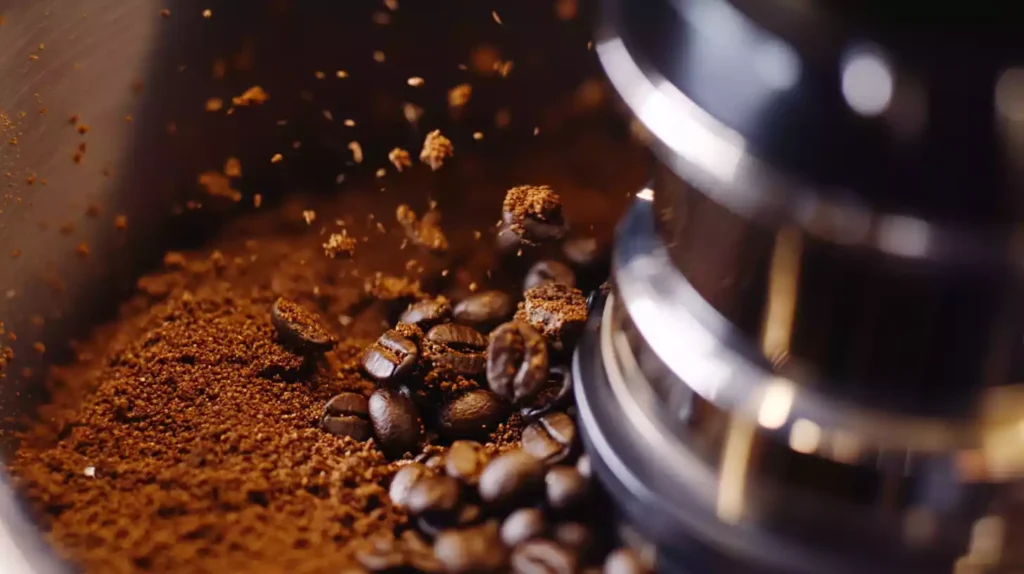I’ve always been fascinated by the intricate process behind a perfect cup of coffee, and my burr grinder plays a crucial role in achieving that perfection. If you’ve ever wondered how these machines transform whole beans into consistently ground coffee, you’re in for a treat.
The inner workings of a burr grinder are both simple and ingenious, combining gravity, precision engineering, and a touch of coffee magic.
But there’s more to this story than meets the eye – the type of burrs, grind settings, and even the way you use the grinder can significantly impact your brew’s flavor profile.
Quick Summary
- Coffee beans are poured into the hopper and gravity pulls them towards the burrs.
- Two abrasive surfaces (burrs) crush and grind the beans between them.
- A motor spins one burr while the other remains stationary.
- The gap between burrs determines grind size, from fine to coarse.
- Ground coffee particles fall through the burrs into a collection chamber for brewing.

Types of Burr Grinders
When it comes to burr coffee grinders, you’ll typically encounter two main types: flat burr grinders and conical burr grinders. Let’s break these down so you can figure out which one’s right for you.
Flat burr grinders have two parallel rings that sit horizontally. They’re like two pizza cutters facing each other, chomping away at your beans.
They’re known for producing a super consistent grind size, which is great if you’re a perfectionist. But here’s the catch: they can be a bit noisy and tend to retain more grounds.
Flat burrs also require regular cleaning to prevent stale coffee buildup and rancid oils, which can affect the taste of your brew.
On the other hand, conical burr grinders have a cone-shaped burr nestled inside a ring burr. Picture a tiny volcano erupting coffee grounds. These bad boys are usually quieter and don’t hold onto as much coffee. They’re also a tad more forgiving if you’re new to the grind game.
Anatomy of a Burr Grinder
A burr grinder consists of five main components that work together to turn your coffee beans into perfectly ground coffee. Let’s look into each part, shall we?
First up, we’ve got the hopper. It’s like a funnel for your beans, sitting pretty at the top of the grinder. Don’t overfill it, or you’ll be cleaning up a mess. Freshly ground coffee provides better flavor and aroma than pre-ground coffee, making the hopper an essential component for coffee enthusiasts.
Next, meet the burrs – the stars of the show. These are two abrasive surfaces that crush and grind your beans. They’re usually made of ceramic or steel, and they’re what give you that consistent grind size.
The motor’s the muscle behind the operation. It powers the burrs, and a good one will keep your grinder running smoothly for years.
The grind adjustment mechanism lets you control how fine or coarse your grounds are. Play around with it – it’s the key to perfecting your brew.
The Grinding Process Explained
Now that we’ve covered the key components, I will explain how a burr grinder actually works. It’s not rocket science, folks, but it’s pretty darn cool.
When you pour those precious beans into the hopper, gravity’s doing its thing, pulling them down towards the burrs.
As you start the grinder, the motor kicks in, spinning one burr while the other stays put. The beans get caught between these burrs, and that’s where the magic happens.
This process ensures consistent grind sizes, which are crucial for perfect coffee extraction and ultimately lead to better-tasting coffee.
The rotating burr crushes the beans against the stationary one, breaking them down into smaller and smaller pieces. The size of the gap between the burrs determines how fine your grind will be.
Want espresso? Crank those burrs close together. French press more your style? Keep ’em further apart.
As the coffee particles reach the right size, they fall through the burrs into the collection chamber below. It’s like a coffee particle graduation ceremony – only the worthy ones make it through. And there you have it, freshly ground coffee ready for brewing.
Grind Size and Consistency
With burr grinders, grind size and consistency are super important for achieving the perfect cup of coffee.
Let me break it down for you.
Unlike blade grinders that chop beans willy-nilly, burr grinders crush them between two abrasive surfaces. This process gives you control over your grind size, from fine powder to chunky bits. Whole-bean coffee offers more brewing flexibility, allowing you to adjust your grind size for different methods.
This versatility is a key advantage over pre-ground coffee.
Why does this matter? Well, different brewing methods need different grind sizes. Espresso? You’ll want it fine. French press? Keep it coarse. Get it wrong, and you’ll end up with a sad, flavorless brew. You don’t want that!
Now, here’s where burr grinders really shine: consistency. Every particle is crushed to roughly the same size, ensuring even extraction. No more bitter surprises from over-extracted fines or weak spots from under-extracted chunks. It’s like having a tiny coffee perfectionist inside your grinder.
Want to adjust your grind? Just twist the dial. Most burr grinders offer a range of settings, so you can fine-tune your grind to your heart’s content. Experiment, find your sweet spot, and never look back. Your taste buds will thank you.
Maintenance and Cleaning Tips
While achieving the perfect grind is important, keeping your burr grinder clean and well-maintained is equally vital. Let’s face it, nobody wants stale coffee oils ruining their brew. So, here’s how to keep your grinder in tip-top shape.
First off, clean your grinder regularly. I’m talking at least once a week if you’re a daily grinder. Use a soft brush to sweep out loose grounds from the burrs and hopper. Don’t forget those nooks and crannies!
For a deeper clean, grab some grinder cleaning tablets. They’re like magic erasers for coffee residue. Just run them through your grinder like you would beans. Easy peasy.
Now, here’s a pro tip: never, ever use water to clean your burrs. You’ll end up with a rusted mess faster than you can say “espresso.” Instead, wipe them down with a dry cloth.
Lastly, don’t neglect your grinder’s exterior. A quick wipe-down with a damp cloth will keep it looking sharp. Trust me, a clean grinder is a happy grinder, and happy grinders make delicious coffee.
Alex is a self confessed coffee addict – but he takes his love of caffeine seriously in a completely responsible way. He loves trying new coffees and testing the latest machines and is not usually fan of one button pod machines. Alex is happiest when he is tinkering with settings and milk temperatures to create the perfect cup. When not obsessing over coffee, Alex is a keen musician and plays weddings and other social events (usually fuelled by… yes, you guessed it… coffee).


